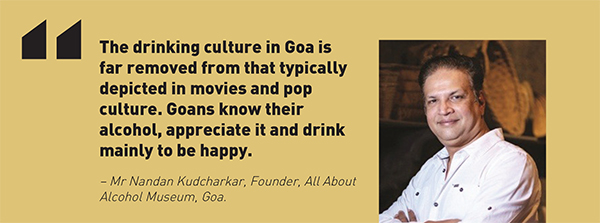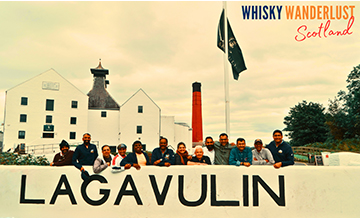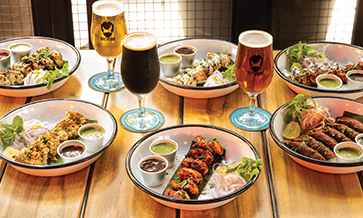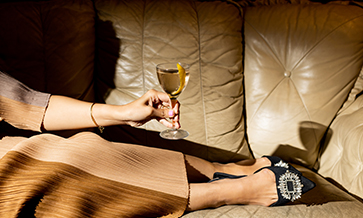Goa conjures up images of sun, surf and sand for the millions of tourists that throng its coastline each year. Decades ago, the Hippies discovered this utopian sunshine state and declared their love for it unabashedly with music, drugs and a gay abandon.
But for an unassuming Goan, attached to the land of his blood and sweat, fish, feni and football is his idea of Shangri-La. A typical tourist to Goa rarely gets to glance behind the gaudy curtain of beach shacks, loud clubs, jet skis and the occasional carnival experience.
But behind the ecclesiastical churches and moss-covered roadside chapels, Portuguese-style homes and the ubiquitous tulsi plant in Hindu households, there emerges another Goa.
The sepia-toned dust of time and memories that settle on history are rarely cleared away as meticulously as at the All About Alcohol (AAA) Museum. What stands out towering above all is the contribution of the several influences over 400 years that have left an indelible stamp on the Goa we see today.
And so it is with feni, distilled from the cashew apple fruit and coconut palm and urrack, made from the first distillation of the cashew apple.
Retracing history
There is an ambiguous debate about who actually distilled the first-ever feni; but knowing the ingenious Goenkar spirit of hospitality and using alcohol as a social lubricant, it does not stretch the imagination to believe that an abundance of cashew apple fruits not wanted by the Portuguese rules meant that it had started to be used to create the local tipple by the mid-18th century.
As much as susegad (a term ascribed to the laid-back attitude of Goans) is a reality, so is the fact that Goan society has been built upon by a myriad of communities: farmers, fisher folk, traders, artists, missionaries, rulers and the ruled.
One can only imagine what tales of travels and trade, of political upheavals, of society scandals and gossip reverberated off the walls of the local tavernas, those old-world watering holes where the working class and sometimes the elite or ruling class would find solace in shots of feni accompanied by ambli (sour slices of raw mango) or khatichem (Goan bread stuffed with pork rind).
The taverns are long gone, and modern tourism has reduced much of the spirited identity of feni to little more than country liquor or toddy.
To retrace the origins of feni through the annals of history AAA, India’s first-ever museum dedicated to local liquors and their historical significance, has opened its doors in Candolim. The museum is not a profit-making venture; it’s a tribute to its founder, Nandan Kudchadkar’s motherland.
Glassware collection
AAA is spread across 13,000 square feet, has five sections, four rooms, and an outdoor area showing the feni stills for cashew and coconut. Nearby is a ‘cellar’ stacked with garraf?es, some filled with feni, and kodem (earthen pots in which the cashew juice was fermented).
While the first room has a collection of glasses and old measuring equipment, the alcohol paraphernalia – glasses, bottles, manufacturing and distilling equipment – is spread throughout the museum.
The collection of glassware includes cocktail and beer glasses, chalices, snifters, inclined wine glasses, the world’s tallest shot glass from Poland, a Queen Elizabeth II June 1953 Coronation glass with gold trimmings, and crystal ware that gives out the most melodious ring when clinked.
An old-style taverna has been recreated with bottles and glassware from Portugal, as well as a feni cellar that houses more than 1,000 bottles of coconut and cashew feni dating back to 1946.
Tasting & pairing
In the cellar, visitors can sample some of this aged feni and be a part of an in-house feni tasting and pairing session. Visitors to the museum’s taverna can enjoy the three signature concoctions: Love, Passion and Karma. They can have the recipes for the cocktails as well.
The other three rooms are packed with items from Nandan Kudchadkar’s collection. Of note are a sugar-cane crusher, a wooden shot dispenser, and a grav (a scale used to measure the potency of feni).
Another room offers the vibe of Goan kitchens, with an old stove, spoons, mortar and pestles, measuring instruments, grinders, packing trunks, old graters and more.
The museum also displays antiques sourced from all over the world: ancient beakers and mud pots, antique wooden shot dispenser, 16th century measuring equipment and a rare Austrian beer horn.
At AAA, the spotlight moves from the beverage itself, to the story behind it. The museum takes its visitors on a wonderful journey, traveling back in time from when Goa became a Portuguese colony, ‘Estado da India’, to its golden years, ‘Goa Dourado’.













